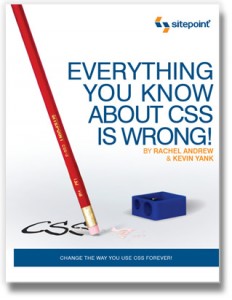
All the hoopla over Everything You Know About CSS Is Wrong!, a book by Rachel Andrew and Kevin Yank (see also the Digital Web article) is making me feel uneasy.
We’re not wrong; the title is wrong
I detest the title of the book. No, I don’t think “everything” I know about CSS is wrong. I “know” about the display:table technique for months now (thanks to Sitepoint, again).
Neither do I think it’s a good idea to go around belittling people by telling them they are wrong, whether in printed book or online article format. It’s harsh and misleading.
We’ve got issues
As for the CSS Tables technique presented in the book, these are some of the issues plaguing it:
- tag soup
- lack of source order control
- the question of semantics and presentation vs. content: is making
<div>s behave like tables/table cells any different from using tables as layouts? - IE6 and IE7 incompatibility (no surprise there!)
And not too long after the uproar, the authors have addressed the above problems:
Andrew Tetlaw responds to #1 and #3:
No one is negatively affected by the overuse of structural div tags. The same can’t be said for the use of HTML tables for layout.
And here’s an interesting quip which points out the very valid woe of web developers, who have had to adjust to all these changes in coding conventions because of our “flakiness”:
Congratulations on years of punishing web devs for using common sense. Finally the circle turns, but somehow you think that you were ‘right all along.
Matthew Pennell of Digital Web has this to say about those who question semantics and standards:
I must say that I’m surprised that an audience of (presumably) conscientious, standards-aware developers are almost all declaring that they will not use new features of CSS when they are available and supported. Are you all so short-sighted that you cannot see any application for the techniques discussed here beyond wholesale replacement of site layouts?
And Rachel has written this regarding #4:
Some commentators have suggested that we shouldn’t have put a book out about a technique that can’t be used immediately, that will require workarounds to still provide support for older versions of Internet Explorer. I disagree. Something I point back to in the book is how the web community began to use CSS for layout even though support in Netscape 4 was limited and buggy. If those of us who were building CSS layouts right in those early days had said, “nah, it doesn’t work in Netscape, can’t do it”, then our recent history would look very different.
Are we hesitant about change and innovation?
In a sense, browser usage does “cripple” our ability to look towards a future of web design innovation (and bliss) when IE6 is finally disappears. But are things right now are exactly the same as when Netscape Navigator 4 was the stumbling block?
More importantly, will the CSS Tables technique actually push our level of innovation by a significant degree? The past few months of new websites tell me innovation is not too hard to come by still.
And what about next-generation HTML5, which will have new structural tags like <header>, <section>, <article>, <footer>? Can one not feel guilty using all those <div>s in the midst of these elegant new tags? Perhaps that’s another debate for another day—in 2022.
Originally posted on October 29, 2008 @ 10:05 pm